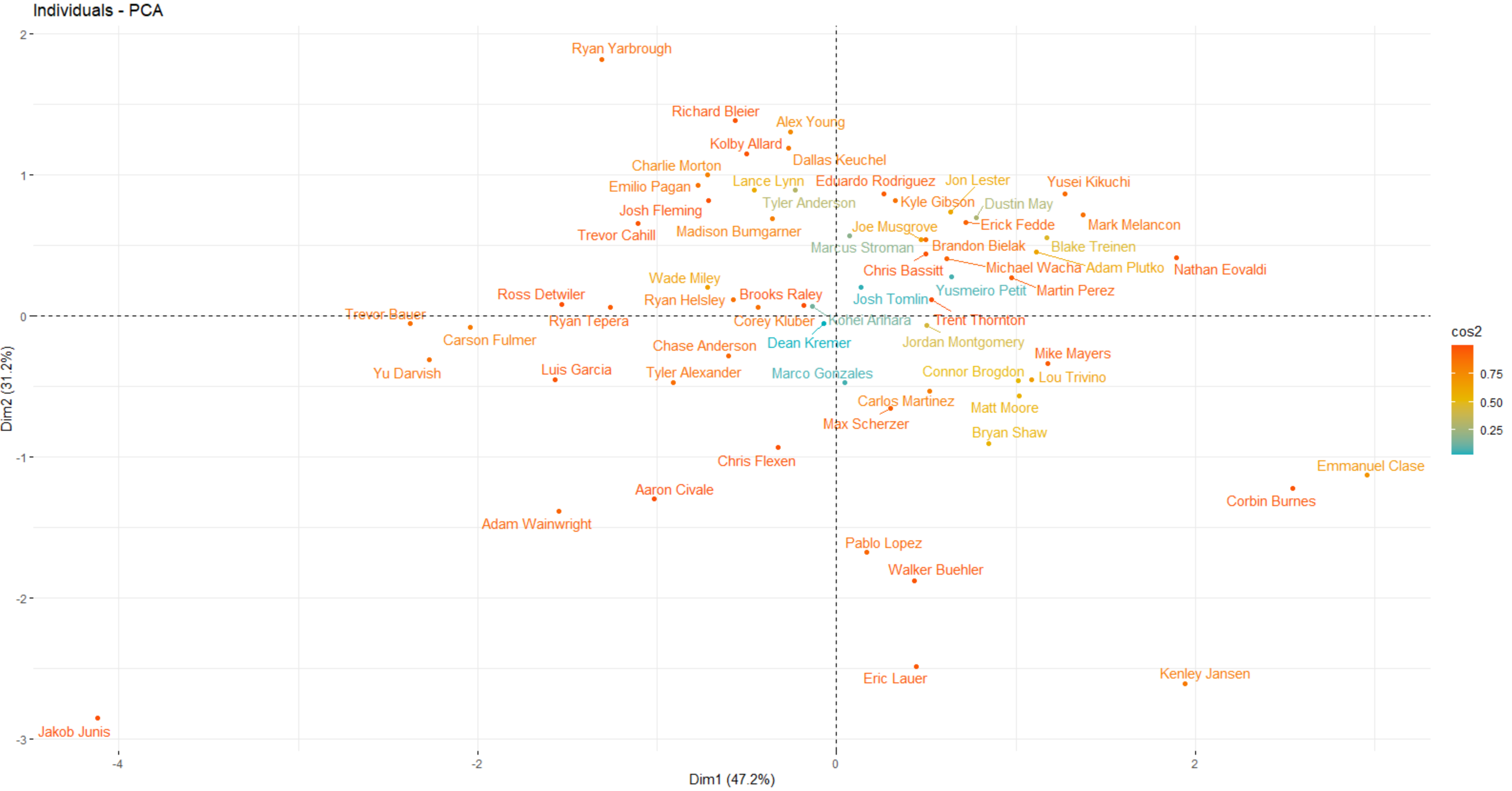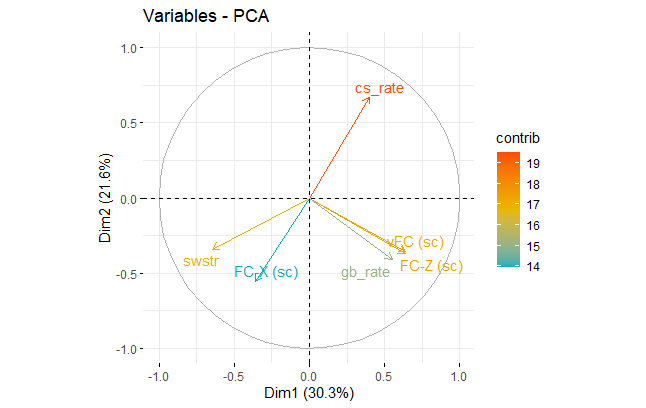Emmanuel Clase Is One of a Kind
Take a gander at the list of the most effective relievers in the majors thus far and you get a mix of known quantities and pop-up guys. That’s the nature of the beast. When evaluating relievers, we deal with small samples and given the talent of any major league pitcher, many have the ability to place atop a leaderboard over a short span of time.
| Name | Team | IP | K% | BB% | GB% | pLI | FIP- |
|---|---|---|---|---|---|---|---|
| Aroldis Chapman | NYY | 15 | 57.4 | 9.3 | 38.9 | 1.51 | 1 |
| Josh Hader | MIL | 15.2 | 45.9 | 11.5 | 19.2 | 2.11 | 21 |
| James Karinchak | CLE | 17.1 | 53.2 | 8.1 | 30.4 | 1.56 | 28 |
| César Valdez | BAL | 16 | 28.6 | 4.3 | 45.7 | 2.69 | 34 |
| Paul Fry | BAL | 15.1 | 37.3 | 10.2 | 64.3 | 1.66 | 35 |
| Ryan Pressly | HOU | 18 | 29 | 4.3 | 63 | 1.26 | 36 |
| Matt Barnes | BOS | 20.1 | 49.3 | 4.2 | 39.4 | 1.73 | 36 |
| Richard Rodriguez | PIT | 17 | 24.1 | 1.7 | 30.2 | 1.58 | 40 |
| Kendall Graveman | SEA | 16.2 | 29.3 | 5.2 | 45.9 | 2.01 | 46 |
| Scott Barlow | KCR | 21 | 31.9 | 9.9 | 40.4 | 1.62 | 46 |
| Josh Sborz | TEX | 17 | 28.2 | 8.5 | 53.3 | 1.12 | 47 |
| Dylan Floro | MIA | 18.2 | 22.4 | 5.3 | 47.3 | 1.94 | 49 |
| Edwin Díaz | NYM | 15.1 | 30.2 | 7.9 | 36.1 | 1.44 | 50 |
| Craig Kimbrel | CHC | 15.2 | 41 | 11.5 | 27.6 | 2.38 | 52 |
| Aaron Bummer | CHW | 15.1 | 29.2 | 10.8 | 76.3 | 1.45 | 55 |
| Jimmy Nelson | LAD | 16.2 | 35.2 | 15.5 | 38.2 | 1.61 | 56 |
| Will Smith | ATL | 16 | 28.6 | 11.4 | 31.7 | 2 | 57 |
| Blake Treinen | LAD | 16.2 | 30.1 | 6.8 | 60 | 1.78 | 58 |
| Drew Steckenrider | SEA | 17 | 29.4 | 11.8 | 56.4 | 0.79 | 60 |
| Taylor Rogers | MIN | 15 | 33.9 | 3.2 | 43.2 | 2.13 | 61 |
| Emmanuel Clase | CLE | 18 | 23.2 | 11 | 72.2 | 1.75 | 63 |
| A.J. Minter | ATL | 17.2 | 26 | 11.7 | 43.5 | 2.16 | 63 |
| Giovanny Gallegos | STL | 23.1 | 29.1 | 5.8 | 35.3 | 1.17 | 64 |
| Mark Melancon | SDP | 18.2 | 21.7 | 4.3 | 68.6 | 2.16 | 67 |
| Phillips Valdez | BOS | 15.1 | 24.2 | 9.7 | 61.5 | 0.5 | 69 |
Readers of this website are almost certainly aware of strikeout artists Aroldis Chapman, Josh Hader, James Karinchak, Craig Kimbrel, and Edwin Díaz. We also see familiar faces Ryan Pressly, Blake Treinen, Taylor Rogers, Mark Melancon, and Will Smith. César Valdez shows up here and is especially notable given his velocity, changeup usage and journey, which has included stops across MLB organizations, Taiwan, and Mexico. Matt Barnes is having a resurgent season. Giovanny Gallegos has been incredibly effective since he arrived in New York after he was part of the trade that sent Luke Voit to the Yankees. But today I want to focus on Emmanuel Clase.
Clase was traded to Cleveland along with Delino DeShields for Corey Kluber prior to the start of the 2020 season. He missed the entire pandemic-shorted campaign due to a PED suspension. Many wondered what to expect from Clase after not throwing a major league pitch for more than a calendar year. Could he be one of the anchors of a Cleveland bullpen with such a long layoff? The early returns are promising. As you can see in the leaderboard above, in 18 innings of work he has compiled a park adjusted FIP 37% better than league average. What sticks out is the method by which he has done so. He has posted a strikeout rate slightly below league average but has more than made up for the lack of missed barrels by inducing groundballs on a shade over 72% of batted balls against him. Arguably more notable than his groundball rate, which is second in the majors among qualified relievers, is his velocity:
| Name | Team | IP | GB% | FA Velo |
|---|---|---|---|---|
| Aaron Bummer | CHW | 15.1 | 76.3 | 95.8 |
| Emmanuel Clase | CLE | 18 | 72.2 | 100.5 |
| Clay Holmes | PIT | 19.2 | 70.7 | 95.6 |
| Mark Melancon | SDP | 18.2 | 68.6 | 91.9 |
| Chris Rodriguez | LAA | 15.2 | 67.6 | 96.8 |
| Tyler Rogers | SFG | 23.2 | 67.1 | 82.2 |
| Paul Fry | BAL | 15.1 | 64.3 | 93.4 |
| Rafael Montero | SEA | 17.1 | 64.2 | 95 |
| John King | TEX | 20 | 64.1 | 93.2 |
| Ryan Pressly | HOU | 18 | 63 | 95.3 |
Clase throws the hardest fastball in the majors and yet has not mustered even a league-average strikeout rate. The velocities in the back of big league bullpens these days and the corresponding rise in strikeouts are well-known phenomenons. Clase has velocity in spades but seems to not being following the league trend with respect to strikeouts. How can this be? His weapon of choice is his cutter:
| Name | Team | Cutter% | Cutter Velocity |
|---|---|---|---|
| Bryan Shaw | CLE | 79.5 | 93.4 |
| Emmanuel Clase | CLE | 74.2 | 100 |
| Mark Melancon | SDP | 63.8 | 91.9 |
| Kenley Jansen | LAD | 58.7 | 91.5 |
| Corbin Burnes | MIL | 54.9 | 95.7 |
| Josh Tomlin | ATL | 51.8 | 86.1 |
| Mike Mayers | LAA | 50.8 | 90.5 |
| Wade Miley | CIN | 49.1 | 85.5 |
| A.J. Minter | ATL | 48.7 | 88.9 |
| Ryan Yarbrough | TBR | 45.2 | 82.3 |
I talked about cutters about a week ago on these very pages. The crux of that piece was that the pitch is a useful tool in a pitcher’s arsenal because of its neutral platoon split; it comes in handy for a pitcher whether he faces a same-handed or opposite-handed batter. The thing about cutters is that generally they aren’t the best pitch for racking up swinging strikes; instead, they can be leveraged to induce groundballs. Clase is clearly leaning into this fact. No one gets more groundballs with his cutter (as a proportion of his batted balls against) than Clase:
| Name | Team | SwStr% | GB% |
|---|---|---|---|
| Emmanuel Clase | CLE | 13.7 | 77.8 |
| Bryan Shaw | CLE | 8.6 | 77.1 |
| Connor Brogdon | PHI | 7.3 | 67.1 |
| Mark Melancon | SDP | 6.4 | 66.5 |
| Matt Moore | PHI | 7.7 | 66.2 |
| Adam Plutko | BAL | 16.8 | 64 |
| Yusei Kikuchi | SEA | 9.9 | 62.9 |
| Wade Miley | CIN | 5.5 | 60.4 |
| Tyler Anderson | PIT | 12.9 | 60.4 |
| Corbin Burnes | MIL | 18.1 | 56.8 |
It is a loaded and arguably over-used word, but the combination of velocity and groundball rate make Clase’s cutter a unique pitch. There is nothing like it in the major leagues. If you are not persuaded, let me offer a visual. Principal component analysis is a method by which an analyst can take columns of numeric data and squeeze it down to strip out any collinearities, parsing through complicated relationships between parameters. It is often used to reduce the dimensionality of large datasets when feeding that data into predictive models, but it can also be leveraged for exploring a dataset and visualizing outliers in that dataset. The first two dimensions (i.e. the variable outputs from the principal component analysis) account for the most variance in the dataset. I first applied this method of analysis to the physical characteristics of all cutters from pitchers who threw the cutter at least 10% of the time. The following visualizes the first two dimensions outputted from the principal component analysis and where the original parameters map onto this new variable space:

I will note that I normalized the horizontal movement of the pitch in terms of handedness. Left-handed pitchers have “negative” horizontal movement because their cutters move opposite those of right-handed pitchers. As you can see, pitchers who are outliers in terms of vertical movement and velocity will appear down and to the right of the graph. Outliers in terms of horizontal movement appear down and more towards the left (you might have to click to enlarge the image due to the number of players included).

The color coding is based on the distance from the origin (the intersection of the two axes). Clase is almost in a league of his own, accompanied only by Corbin Burnes. This is not too surprising given that Burnes is among the league leaders in cutter velocity. The two pitchers get different results with the pitch. Burnes is able to induce a ton of swinging strikes with his cutter (18.1% of all cutters), about 40% more than Clase. Clase, on the other hand, induces more groundballs with the pitch (on a rate basis) than any other pitcher in the majors. So let’s run the analysis again, but incorporate swinging strike rate and groundball rate along with the physical characteristics of the pitch. For context, here is the same variable visual as above, now with swinging strike rate and groundball rate incorporated:

With that additional context in hand, how does Clase compare to his peers?

Clase is all the way out there on his own, just like I postulated. The combination of its physical characteristics and results makes Clase’s cutter stick out from the rest of the pack. Some may wonder whether a pitcher with a below average strikeout rate can excel as a back-of-the-bullpen piece in this era of baseball. Given his unmatched velocity and uncanny ability to saw-off opposing barrels, I think Clase can maintain this success going forward without bushels of strikeouts. Of course, only time will tell and relievers are volatile. But I am confident the unique look of Clase’s cutter will continue to make him one of the most feared bullpen weapons in baseball.
Carmen is a part-time contributor to FanGraphs. An engineer by education and trade, he spends too much of his free time thinking about baseball.
UPDATE: Aroldis Chapman’s FIP- is now -2 (negative 2).
Because a FIP of positive 1 is too pedestrian….